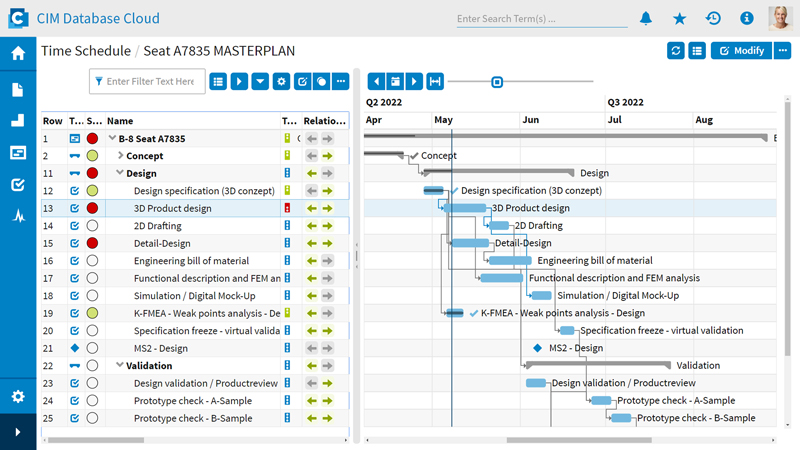A conversation with Frank Patz-Brockmann, Director Software Development, Contact Software.
After the official launch of the CIM Database Cloud, I was able to have a conversation with Frank Patz-Brockmann, Director Software Development at Contact Software, in which he gave me a deeper insight into the special features and performance of the cloud PLM system.

Frank Patz-Brockmann, Director Software Development (Photo Contact Software)
Ulrich Sendler: Mr. Patz-Brockmann, is CIM Database Cloud a slimmed down version of CIM Database?
Frank Patz-Brockmann: No, it’s the same software that can also be installed on-premises. The basis is our very comprehensive Contact Elements platform, in which a company can find all the functions and modules it needs for a complete PLM strategy.
A number of customers are already using CIM Database in the cloud, as we have been offering this operating model for almost two years – but without actively advertising it so far. You have the choice between two product versions: If customers opt for CIM Database as Software-as-a-Service (SaaS), they receive standard software out-of-the-box with a few setting options.
With a Platform as a Service (PaaS) license, companies have roughly the same options for adapting our PLM system to their specific requirements beyond the standard functionality as they do with an on-premise installation. In both cases, we take responsibility for the entire infrastructure and runnability.
Ulrich Sendler: What is meant by the extension packages that the press release says a customer can opt for?
Patz-Brockmann: Our product portfolio includes more than 60 specialist applications for the entire product lifecycle, which can be flexibly combined. From these, we have put together three packages with different functional scopes that are tailored to the respective degree of digitalization of companies in the product creation process: Collaborate, Accelerate and Innovate.
Ulrich Sendler: At the same time, customers can also choose between fixed licenses per user and pay per use. Can you explain that briefly?
Patz-Brockmann: There are two pricing models. Subscription per user is a monthly price per user or per workstation. For a few months now, we have also been offering a dynamic price because we can record the usage time of users – with their consent, of course. This allows customers to get a much lower base price per installation. For users who do not work with the system on a daily basis, but only use it for a few hours a week or even a month, there is an important savings potential here. After a certain number of hours, it may become more expensive than the full license. By recording the usage time, the more sensible solution is transparent for the customer.
Ulrich Sendler: On which cloud platform does CIM Database Cloud run?
Patz-Brockmann: We chose Amazon Web Services (AWS) after careful consideration of all the important aspects compared to other offerings. In addition to the security of the server environment and the data managed there, the performance of the solutions and services provided for automating infrastructure management is at least as important. In that respect, we are currently in very good hands with AWS.
A number of customers have committed to Microsoft Azure as their platform. Our cloud solution runs just as well there. But in these cases, we don’t offer services and only sell licenses. Here, the customer and his IT department are responsible for the infrastructure, updates and so on, just as before.
But we can switch to another platform at any time. There are no AWS-specific services built into our software that would make us dependent. A customer running OpenShift, for example, could easily run our CIM Database Cloud as a Docker container.
Ulrich Sendler: Is the basis of your cloud offering the decomposition of CIM Database into microservices, as is typical for composable software?
Patz-Brockmann: A microservice prophet would deny that. We have not implemented every function and every single element of our platform as a microservice – and for good reasons. The entire PLM offering is based on the idea of being able to link data from a bill of materials with data from a project, for example. To do this, project management and bill of materials management must access one and the same database. With a pure microservice, only the data that belongs to the respective function is available.
But at the basic level, of course, the following applies: How we store data, incorporate search engines, implement user authentication – that’s what we use microservices for.

Project management with CIM Database Cloud (image: Contact Software)
Ulrich Sendler: Is there a difference in terms of functionality between the cloud solution and the on-premises installation?
Patz-Brockmann: No. At the moment, perhaps one or two percent of the full range of functions is still missing in the cloud. But that is only a question of time. We will soon be offering the full scope in the cloud as well. What is a little more complicated are the interfaces to ERP. Our software is characterized by its excellent integration capability, which we also want to offer in the cloud. However, accessing data across system boundaries works differently in the cloud than with on-premises. That’s why not all Contact Elements modules here are cloud-ready yet. But they will be soon.
Ulrich Sendler: Will these interfaces be based on the standard REST API in the future?
Patz-Brockmann: REST API is a very basic technology and we support customers who work with it. But we have the ambition to also offer the functionality in the cloud that we can only realize with direct interfaces.
There are very different levels of maturity among customers. Larger ones may already have their own cloud landscape, while smaller ones tend to struggle with this. In the case of ERP in particular, we try to retain the performance scope of the previous solution, even if we work largely in the cloud. You can switch that to REST API, but the traditional way of connecting can do much more, and that applies – even to a special extent – to CAD as well.
Ulrich Sendler: You said the cloud solution has been in productive use for almost two years. What is your experience with it so far?
Patz-Brockmann: It is an amazing success story. Our cloud business is currently about doubling every year. Customers are discovering and loving the great benefits of having the operation and management of the infrastructure taken off their hands. Many have switched completely to using the standard solution, forgoing major customizing. Based on experience to date, it seems clear that the future also in PLM lies in the cloud.
